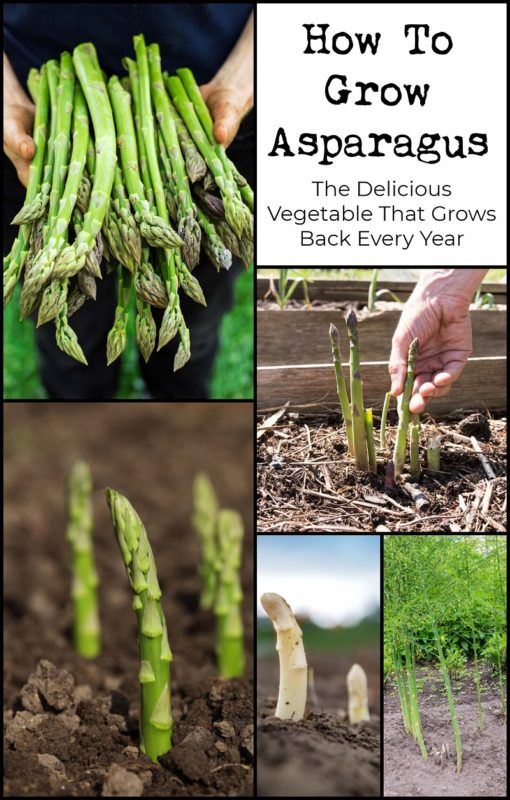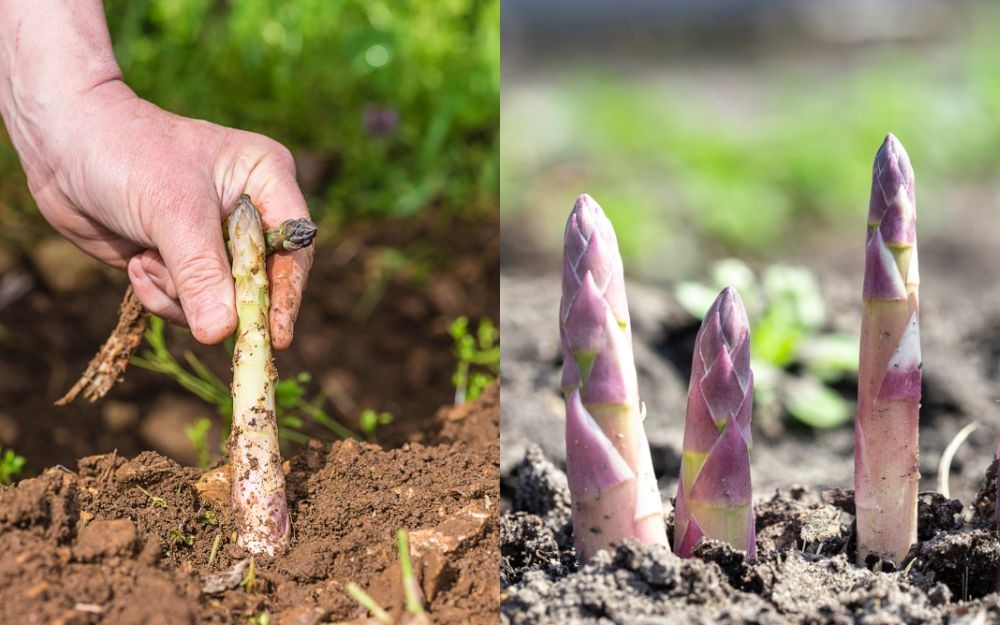
Growing asparagus (Asparagus officinalis) requires patience but boy, is the payoff worth it.
Although it takes up to three years to really get going (unless you buy asparagus crowns), this perennial plant will produce a bountiful harvest year after year for up to 30 years.
In addition, the plant itself is quite attractive with a long feather-like top that turns a warm golden hue in the fall and makes a powerful statement in your garden.
Native to Western Europe, asparagus does best in areas where the ground freezes in winter or there are dry seasons.
In wet and warm areas such as Florida and the Gulf Coast, it is difficult to grow this plant because it is just too moist.
If you live in the USDA planting zones 2-8, you can plant asparagus and expect a generous return for your time and energy.
Growing Asparagus From Seed
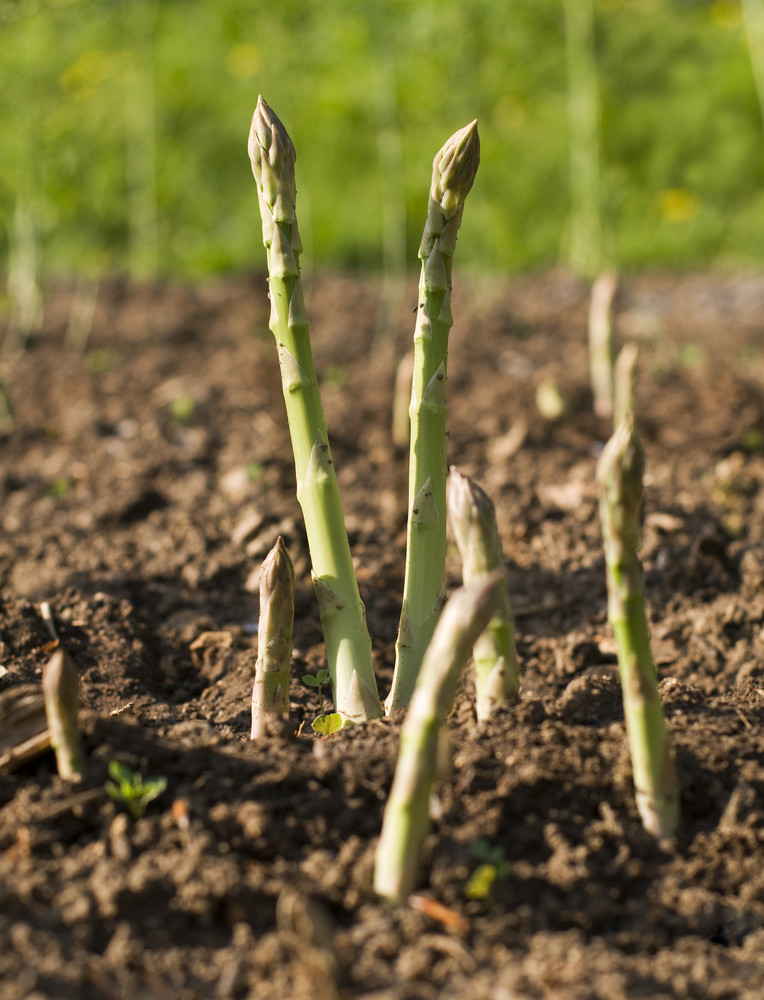
If you have acquired seeds (these are the best reviewed seeds on Amazon) or perhaps even harvested some seeds from a previous crop, you can grow new plants.
It is best to start seeds inside or in the warmth of a greenhouse in mid-February to May.
Seeds require bright light and soil temperatures between 70-85 degrees for germination. I find it works best to soak the seeds for a couple of hours before planting as well.
- Fill 3.5-inch pots with sterile soil.
- Place 3 seeds on the surface of the soil in each pot.
- Cover the seeds with a thin layer of sifted sand.
- Bottom water all pots by placing in a pan with sides with water.
- Place on a heated table to be sure that the soil stays warm.
- Do not let pots dry out.
- Allow the seedlings to grow for three months before transplanting as long as all risk of frost has passed.
- Place transplants about 18 inches apart in rows that are 4 inches apart. For thinner spears, place them 8 to 10 inches apart and 4 inches deep. For thicker spears, place them 12-14 inches apart and 6-8 inches deep.
- Cover the seedlings with a light layer of soil as they grow.
- Provide one-inch of water each week.
- Remember, don’t harvest for three years – allow the plant to grow all summer and cut it back to 2 inches in the fall.
Growing Asparagus From Crowns
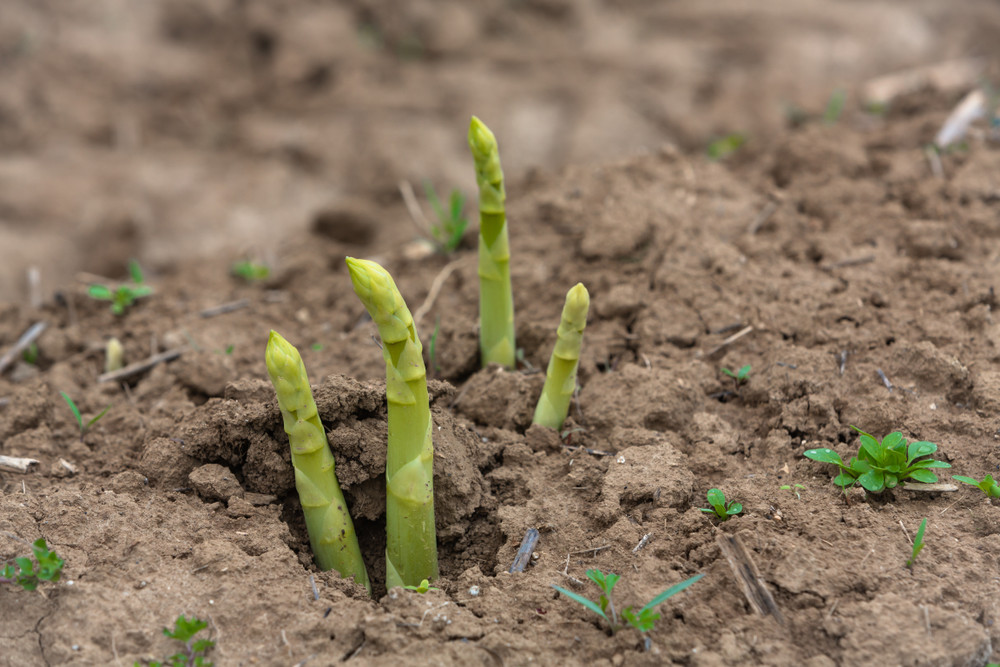
I have been ordering asparagus crowns in the mail in late winter for years. Just be sure that you choose a reputable supplier and pick a variety best suited for your growing zone.
It is important to prepare your bed ahead of time so that you are ready when the crowns arrive.
Asparagus likes soil that is pH neutral and somewhat sandy and loose that drains well. I have had the best luck growing asparagus crowns in 2 x 8 raised beds.
My beds hold about 14 asparagus plants. If you are going to grow asparagus in with other vegetables, plant it on the north or west side of the garden so that it will not shade other vegetables.
- Work compost into the soil.
- Dig two 12-inch deep furrows in the raised bed.
- Put one cup organic fertilizer in each furrow.
- Mound up loose dirt into cone-shaped piles about 6 inches tall at the bottom of the furrow. Leave 18 inches between each cone.
- Put an asparagus crown on top of each dirt pile in the furrow. The roots should hang down over the dirt pile.
- Cover the crowns with about 1-inch of soil.
- Keep the soil moist but do not saturate.
- Keep weeds out of the bed.
- Add more soil as the asparagus continues to grow.
- Continue this process until the furrow are filled to ground level with the soil.
- Do not harvest for two years, let the spears grow to into ferny plants and develop deep roots.
Tricks Tor A Bigger & Better Asparagus Harvest
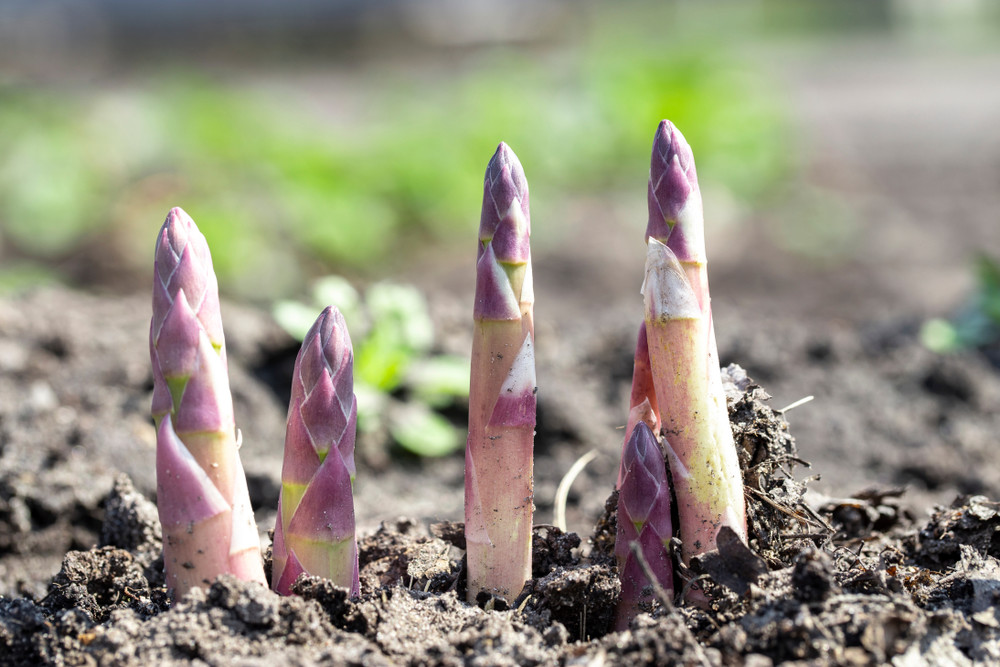
Plant asparagus seedlings near tomatoes. Asparagus repels nematodes that attack tomatoes and tomatoes repel asparagus beetles. Companion planting can really aid your growing efforts.
Harvest new asparagus crops for four weeks in year three and for six to eight weeks in year four and on.
Asparagus plants are either male or female. There are some varieties such as Jersey Knight and Jersey Giant that produce all male plants so that they are more productive. Choose an all-male variety if you want a bigger yield.
Apply mulch to suppress weeds.
Soak crowns in compost tea before planting to give them a burst of energy.
After harvest, allow plants to grow to replenish nutrients. Wait until the foliage has turned brown or yellow – usually in the fall. Cut down to 2 inches.
Fertilize established crowns in spring and fall using a rich organic fertilizer/compost containing things like fish, seaweed, kitchen scraps including bread dairy fruits and other vegetables.
Add rock phosphate to trenches each year before planting new crowns.
Harvesting & Storing Asparagus
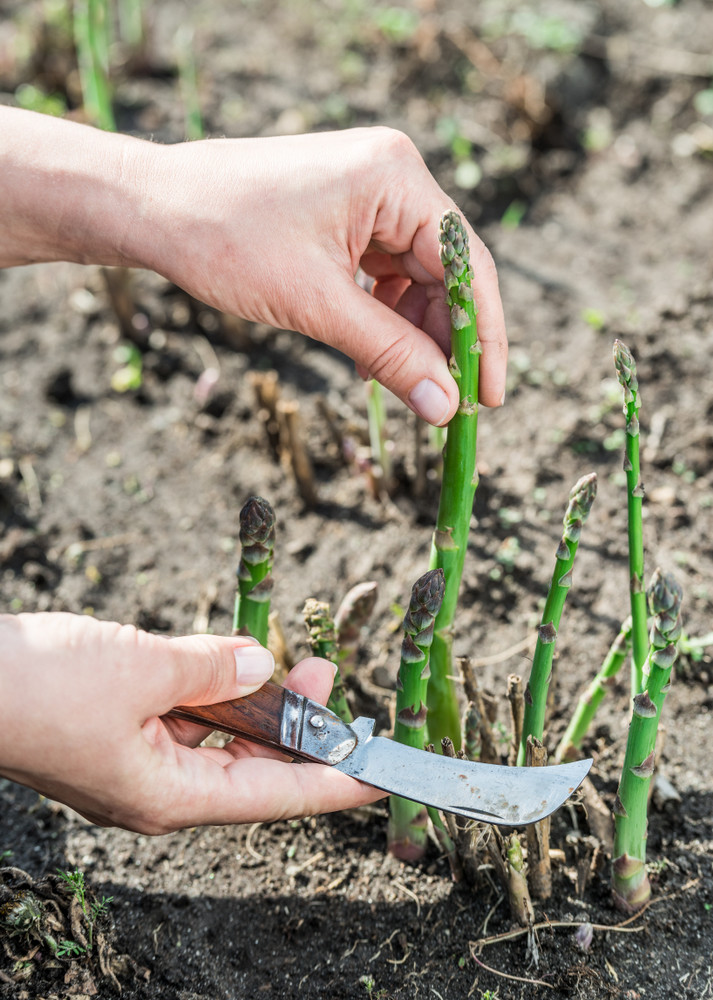
When asparagus plants are robust enough for harvesting, cut off new spring shoots when they reach about 8 inches in height.
Use a clean and sharp knife to cut just below the soil line. Do not harvest spears once the plant has begun to develop foliage. To keep this from happening, harvest every other day.
Plants will produce anywhere from 2 to 8 weeks depending on their maturity and strength. Keep harvesting until the spear diameter measures the size of a pencil.
Cook harvested spears immediately or store in a plastic bag in the fridge for up to a week or more. For long-term storage, blanch spears in boiling water for five minutes, dry and store in freezer bags.
Health Benefits Of Asparagus:
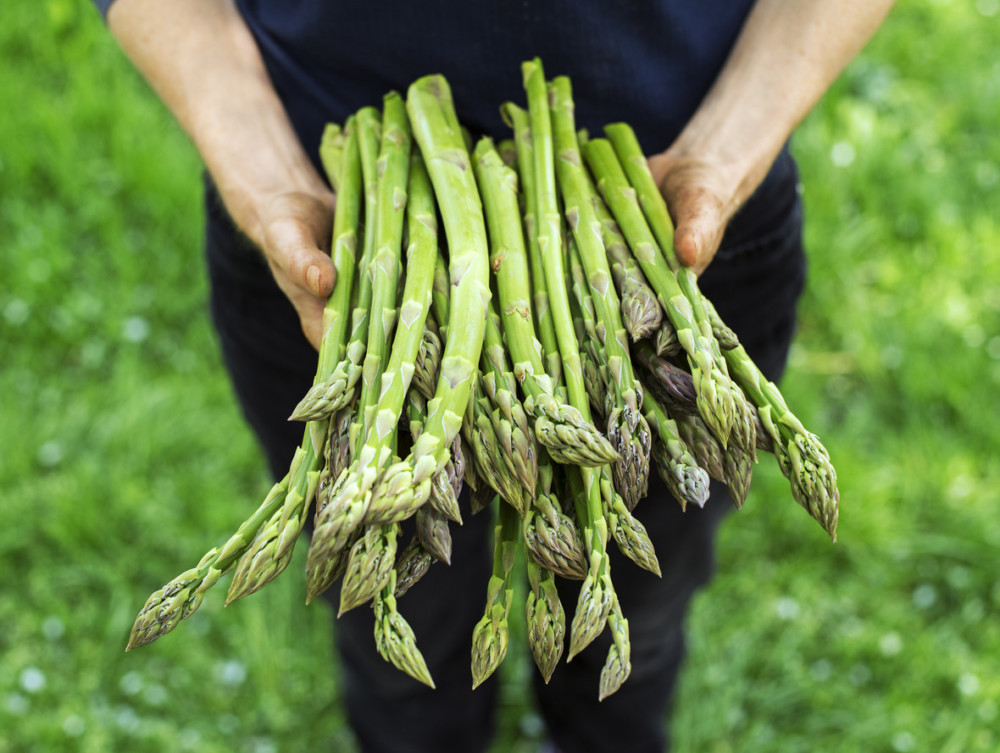
Asparagus is known to be one of the most nutritionally well-balanced vegetables around. It is loaded with folic acid and also offers a good amount of potassium, fiber, thiamin and vitamins A, B6, E, K, and C.
Asparagus can aid in weight loss:
Asparagus is low in fat, low in calories and contains both soluble and insoluble fiber. The body digests fiber very slowly and this helps you feel full between meals – making asparagus a great food if you are trying to drop pounds. Try pairing some asparagus with healthy protein such as a hard-boiled egg to boost that full feeling.
Asparagus can help keep your urinary tract healthy:
Asparagus contains the amino acid asparagine which is a natural diuretic. When women don’t urinate enough they can develop a urinary tract infection. Eating this healthy green veggie on a regular basis will help prevent urinary tract infections by flushing excess fluid and salt out of the body
Asparagus can strengthen your immune system:
Asparagus contains vitamin E which supports a healthy immune system while protecting cells from free radicals. Because we absorb vitamin E better when it is eaten along with some healthy fat – roasting asparagus in olive oil will boost its effectiveness.
Asparagus is a natural aphrodisiac:
If you are looking to rev up your love life, try eating asparagus, a natural aphrodisiac. Vitamins B6 and folate help increase arousal and vitamin E stimulates sex hormones. Planning a dinner for your sweetheart? Don’t forget the asparagus.
Asparagus can improve bone health:
Because asparagus is rich in vitamin K it can help your body absorb calcium which is necessary for bone strength.
Asparagus can make you smile:
Not only does asparagus contain folate, a B vitamin that has been linked to reducing irritability but it also contains a great deal of the amino acid called tryptophan that has been shown to have a positive impact on mood.
Delicious Asparagus Recipes:
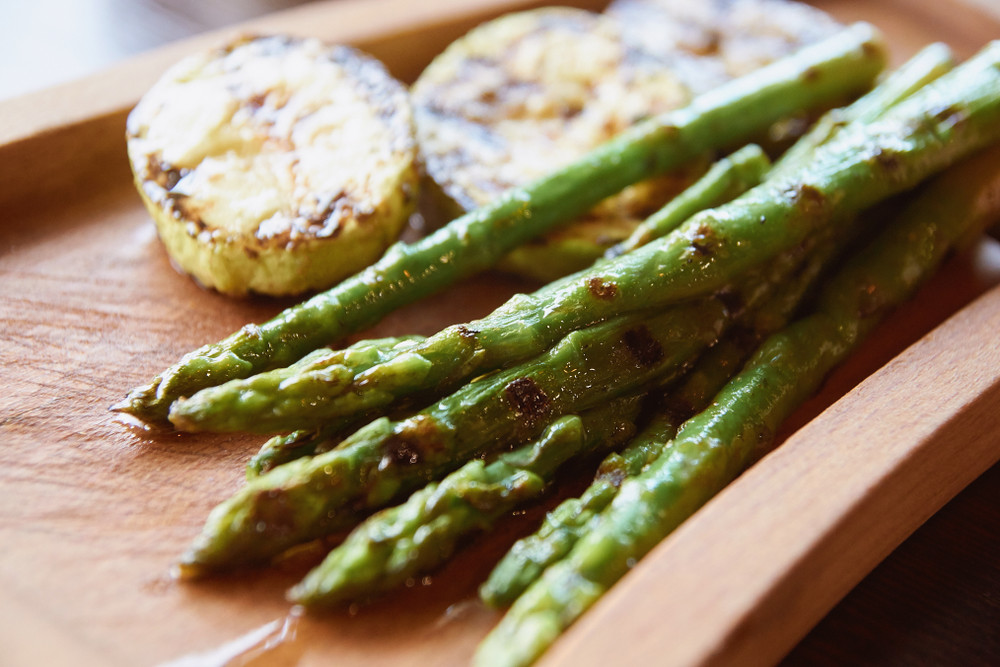
To enjoy all of the goodness of this nutritionally rich veggie, try these delicious asparagus recipes.
Asparagus & Tomato Melt
This dish makes a great side but can also be enjoyed as a meal on its own.
Ingredients:
- 1 lb. asparagus stalks trimmed
- Extra-virgin olive oil, for drizzling
- Sea salt
- Freshly ground black pepper
- 2 c. shredded mozzarella
- 2 c. cherry tomatoes halved
- 1/2 c. balsamic vinegar
- 1/4 c. raw honey
- Basil for garnish
How To Make It:
- Preheat oven to 425 degrees F.
- Toss asparagus with olive oil and season with salt and pepper.
- Place on one side of a large baking sheet and sprinkle mozzarella on top.
- Toss cherry tomatoes with olive oil and season with salt and pepper.
- Place them on the other side of the baking sheet.
- Bake until asparagus is tender and cheese melts. Usually about twenty minutes
- Combine balsamic vinegar and honey in a small saucepan and simmer for about fifteen minutes. Let cool.
- Place roasted asparagus on a plate, top with tomatoes and drizzle with balsamic glaze.
- Garnish with fresh basil.
Asparagus & Orange Salad
This salad is the perfect combination of sweet and rich.
Ingredients:
- 2 heads of Boston lettuce, torn
- 1 large red onion, sliced into rings
- 2 seedless oranges peeled and sliced
- 1 lb fresh asparagus spears, blanched
- Fresh lemon juice
- Oil and vinegar dressing
How to make it:
Top lettuce with all ingredients. Squeeze lemon over salad and drizzle with olive oil and vinegar.
Summer Lemon Pasta
This pasta salad is the perfect compliment to your backyard dinner party.
Ingredients:
- Sea salt
- 1 lb Gluten-free macaroni
- 1 bunch asparagus, trimmed
- Extra-virgin olive oil, for drizzling
- Freshly ground black pepper
- 2 Tbsp. butter
- 2 cloves garlic, minced
- 1/2 red onion, diced
- 1 c. dry white wine
- 2 lemons
- 1/2 tsp. crushed red pepper flakes
- 1 c. freshly grated Parmesan, plus more for garnish
- 1/2 c. fresh chopped parsley, plus more for garnish
How to make it
- Cook the pasta according to the package directions and save the water
- Drizzle olive oil over asparagus. Grill asparagus in a grill pan over medium-high heat for four minutes on one side. Flip the asparagus and cook for two more minutes.
- Cut asparagus into 1-inch pieces.
- Cook butter, garlic and onion until soft.
- Add white wine, the zest from one lemon, 1 tablespoon lemon juice, pepper flakes, salt and pepper. Bring to a boil and simmer for about 5 minutes.
- Take the pot off of the heat and mix in pasta water, asparagus, cheese, parsley and pasta until well coated. Garnish with cheese and a little parsley and serve with lemon wedges.
Pin To Save For Later
